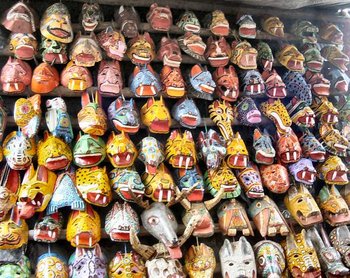Mask
|
|
- This article is about masks fitted on the face as an article of clothing or equipment. See Mask (disambiguation) for other meanings.
Mask_dino_reading.jpg
A mask is a piece of material or kit worn on the face. Masks have been used since antiquity for both ceremonial and practical purposes.
The word "mask" came via French masque and either Italian maschera or Spanish másquera. Possible ancestors are Latin (not classical) mascus, masca = "ghost", and Arabic maskharah = "jester", "man in masquerade".
| Contents |
Ceremonial uses
- In ritual, social and religious functions, where participants wear them to represent spiritual or legendary figures. In some cultures it is also believed that the wearing of a mask will allow the wearer to take on the attributes of that mask's representation; i.e., a leopard-mask will induce the wearer to become leopard-like.
- In Mexico and Central America, most towns have both a Christian name and an indiginous name, for example, Santiago Tianguistenco, or Santa Maria Axixitla. All Christian saints have a specific day in the year dedicated to them, and each town typically has a festival on that day, involving a combination of Christian and indiginous tradition. These festivals frequently include parades and street theatre that act out a story. The masks and costumes from these festivals have become collectors items. A mask used in such a festival is known as having been "danzada" or "danced." These hand-made, painted masks are typically made from wood and may use rope, animal horns or teeth, or rubber from tire inner tubes.
- In Africa, especially West Africa, masks also play an important role in traditional ceremonies and theatrical dances. All African masks fall into one of four categories: the ancestor spirit, the mythological hero, the combination of ancestor and hero, and the animal spirit.
Entertainment
- In theatre plays. Use of masks in the dramatic plays in Ancient Greece evolved from the ceremonial purpose. Masks are also a defining characteristic of the Noh theatre of Japan. The English word "person" came from a Latin word for a theatrical mask: per-sona = "through-sound" = "what the actor's voice comes through". The Ancient Greek word prosōpon = "face" originally meant "in front of the face", i.e. "theatrical mask".
- To provide an aura of mystery with professional wrestlers, as well as entertainers like the Unknown Comic, who always wore a paper bag over his head.
- As a part of carnival celebrations in some parts of the world; Venice is most famous for this.
- As part of the costume of a particular personage like Harlequin or a modern comic book superhero. Another common use as such is by professional wrestlers, particularly in Mexico.
- Latex masks are used in cinema as part of elaborate character makeup.
- Here also may be included masks worn at masquerade balls.
To stop the wearer from being recognized
- Criminals often use masks to avoid identification when they commit crimes. In many jurisidictions, it is an additional criminal offense to wear a mask while committing a crime; it is also often a crime to wear a mask at public assemblies and demonstrations.
- Occasionally a witness for the prosecution appears in court in a mask to avoid being recognized by associates of the accused.
Protective
Protective masks have these functions:-
- Providing a supply of breathable air or other oxygen-containing gas.
- Protecting the face against flying objects or dangerous environments, while allowing vision.
Many masks have both functions.
This category merges into the categories of goggles and protective helmets and visors.
Here are included:-
- A cloth tied over the mouth and nose as a dust filter.
- Filter masks.
- Surgical masks.
- Gas masks.
- The familiar eyes-and-nose diving mask.
- Breathing masks connected to some industrial breathing sets. These are usually fullface.
- Breathing masks connected to some underwater breathing sets. These are usually fullface. See this link and this link for examples.
- Oxygen masks worn by high-altitude pilots.
- Oxygen masks used as part of medical oxygen resuscitation kit.
- Anaesthetic masks used in surgery in hospitals.
- Sport masks such as fencing masks or ice hockey and American football goalkeeper's masks.
- Ski masks.
- Welder's masks.
- The faceplates of spacesuit helmets.
Of masks that supply breathable air, some also cover the eyes (full-face); and some only cover the mouth and nose, and the wearer must also wear goggles.
Other types
- A "life mask" is a plaster cast of a face, used as a model for making a painting or sculpture.
- A "death mask" is the same but taken from the face of a recently dead model. Death masks were very popular in the Western World during the 18th and 19th century.
Both methods can preserve a realistic three-dimensional portrait.
External links
|
- The Secret of Masks (http://www.boheme-magazine.net/php/modules.php?name=News&file=article&sid=28)

